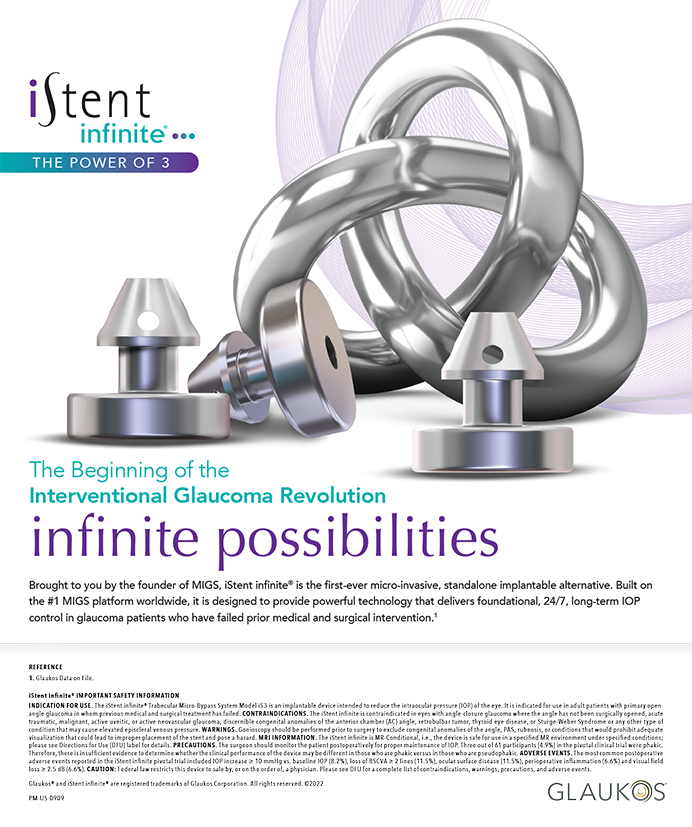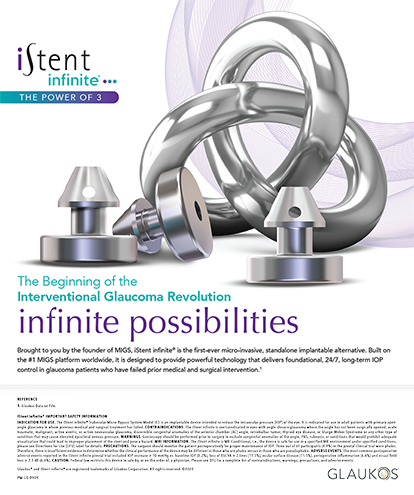For the past few years, many surgeons have focused on improving new customized corneal ablation techniques in order to optimize patients' optical systems. The goal of this research is to create a high-quality retinal image, while taking into account anatomical as well as functional and optical factors of the eye.
THE WAVEFRONT ABERRATION FUNCTION
The wavefront aberration function describes the optical quality of the eye. This important term refers to the result of an eye's total aberration components, including defocus, astigmatism, coma, spherical aberrations, and other higher-order aberrations. Mathematically, physicians depict this aberrated function in terms of Zernike polynomials.
Refractive corneal laser surgery currently focuses on correcting second-order aberrations (defocus and astigmatism), which are considered the most disturbing optical aberrations of the human visual system. However, several studies associate these corrections with an increase in higher-order aberrations such as coma, particularly in cases of decentration or spherical aberration combined with moderate-to-high myopia.1 An increase in these types of aberrations relates to a significant decrease in quality of vision (ie, contrast sensitivity), especially under mesopic and scotopic conditions. Wavefront-guided corneal ablation technology was developed to correct traditional refractive errors, such as sphere and cylinder, and reduce higher-order aberrations.
THE SYSTEM
The Zyoptix wavefront-guided corneal ablation system combines the Zywave wavefront aberrometer, Orbscan IIz corneal diagnostic unit, and the Technolas 217z excimer laser (all products manufactured by Bausch & Lomb Surgical, San Dimas, CA). This system creates a one-step customized corneal ablation procedure to correct defocus and astigmatism as well as higher-order aberrations. The Zywave aberrometer system is based on the Hartmann-Shack aberrometer. Both the wavefront profile that the Zywave produces and the corneal thickness and corneal elevation data from the Orbscan II are exported to the Zylink software. The software then designs a customized ablation pattern based on this information, and downloads it to the Technolas 217z laser. The laser operates with scanning spot technology and has been upgraded to optimize the ablation pattern needed to correct higher-order aberrations. Using a quartz card, the laser adds a 1.0-mm truncated Gaussian spot to the 2.0-mm “top hat” spot. In this way, the 2.0-mm spot corrects the majority of the refractive error, and then the 1.0-mm spot finishes the treatment by correcting any higher-order aberration.
FLAP-INDUCED CHANGES
Zyoptix is a promising customized corneal ablation procedure for correcting higher-order aberrations. However, it seems unlikely to correct second- and higher-order aberrations in one step. For example, creating the flap may induce optical changes: the hinge generates astigmatism and biomechanical changes in the cornea, and the ablation itself increases spherical aberration due to the spherocylindrical correction. Surgeons should consider these factors when calculating the treatment in order to maximally reduce the aberrations of the eye.
These conclusions are based on the results from a study of 30 patients (aged 20 to 51 years) who exhibited myopia ranging from -1.0 D to -12.0 D and cylinder of -5.0 D or less, and who underwent this first approach with the Zyoptix procedure. Due to these flap-induced changes, my colleagues and I could not optimally correct patients' higher-order ab-errations with this procedure, nor was the stability of the corrections constant. We therefore designed a new ap-proach to the Zyoptix procedure that controls flap-induced and ablation-induced changes.
A TWO-STEP APPROACH
We developed the Zyoptix ablation refinement (ZAR) technique, based on the Zyoptix procedure, to correct residual myopia and astigmatism and to minimize higher-order aberrations induced by primary LASIK surgery. In this two-step technique, the first step is to obtain a smooth surface with minimal spherocylindrical error. The second step then corrects the higher-order aberrations. In a pilot study, the ZAR technique proved safe, effective, and highly predictable following standard excimer laser LASIK surgery.
In this procedure, we include patients with various de-grees of residual myopia and astigmatism following standard PlanoScan (Bausch & Lomb Surgical) LASIK surgery with the Technolas 217 laser. Patients receive a refinement procedure after at least 3 months of follow-up from their conventional PlanoScan correction. After relifting the flap, we perform a Zyoptix customized ablation, which features software designed for performing enhancements, to correct patients' higher-order aberrations. This system also integrates wavefront analysis, three-dimensional elevation corneal mapping, and advanced scanning laser technology.
COMPARING THE DATA
Our clinical experience with these two approaches reveals that the ZAR technique may be the most suitable treatment approach for reducing higher-order aberration, especially in cases of residual myopia. Studies concerning the biomechanical changes of the cornea note that the more we sculpt the cornea with a laser, the more we cause biomechanical idiosyncratic stromal changes that mask the subtle effects of any sculpting.2 A two-step strategy may be the best solution for this problem: We perform the spherocylindrical ablation in the first LASIK treatment, which allows the idiosyncratic changes to take place. After 3 months, we relift the flap to correct higher-order aberrations while minimizing the healing response. Consequently, the enhancement procedure corrects both higher-order aberrations as well as aberrations induced by the original LASIK procedure.
Our experience using the ZAR technique shows promising results regarding both quantity and quality of vision. In an initial study my colleagues and I conducted in our clinic, 83.3% of the patients (18 eyes) subjectively noted an im-provement in their visual acuity and an absence of the symptoms that previously impaired it. These responses corresponded with the improvement in the patients' contrast sensitivity, especially in medium-to-high frequencies
(12 cycles per degree) (Figure 1). This study also revealed a decrease in higher-order aberration in 83.3% of the eyes after 6 months (Figure 2). The amount of third-order aberration decreased in 50% of eyes, and fourth-order aberration decreased in 22.2% of eyes. We also noticed that patients clearly appreciated the benefits of this reduction, especially young patients who had large pupil sizes.
IN CLOSING
My colleagues and I consider the two-step approach an adequate method to improve optical performance and significantly reduce the aberration profile of the operated eye. Wavefront-guided LASIK is a promising technique that requires further research and refinement. Prospective controlled and standardized clinical trials will reveal more information about this innovative technology, and a prospective clinical trial on the ZAR technique and the quality of vision it produces is currently underway in Alicante, Spain.
Araceli Cáliz, OD, practices in the Research, Development and Innovation Department of the Ophthalmologic Institute of Alicante. She holds no financial interest in any technology discussed herein. Ms. Cáliz can be reached at +34 965 150 025.
1. Marcos S, et al. Aberrations and visual performance following standard laser vision correction. J Catar Ref Surg. 2001;17:596-601.
2. Alio J. Wavefront-oriented LASIK enhancement: a step forward in aberration-free refractive surgery. Paper presented at: AAO meeting; October 22, 2001; Orlando, Florida.


